1 . French schools once prized the nutritional value of wine. So commonly was it served to children that in 1956 the government banned wine in school canteens—and even then, only for the under-14s. France was the world’s biggest wine producer last year. A bottle of wine has long been to the French meal what fast driving is to the German motorway: an ordinary habit, national right and personal pleasure.
No longer. In 2022 roughly 10% of French people drank wine every day, down from half in 1980. Back in 1960 the French drank an average of 116 liters of everyday wine per person. Between 2000 and 2018 that shrank from 28 liters to just 17. A glass of wine is an increasingly rare sight at the lunch table.
What is going on? It is not simply price. A bottle of Bordeaux can still be found in a French supermarket for under €3. Some village co-operatives sell local produce straight from the vat for €l.90 a liter—less than fresh orange juice. A better explanation is that a beer-drinking trend is challenging Mediterranean habits. The French now tell polls that they prefer beer to wine. Beer accounts for more than half of all alcohol bought in French supermarkets. Even in southern France, some cafes serve imported Belgian or German beer on tap.
Most important, a health-conscious younger generation is drinking less. A quarter of French 18- to 34-year-olds say they never drink alcohol. Fully 39% of under-35s say that they do not drink wine, next to only 27% of the over-50s. Le dry January has entered the national vocabulary. No- and low-alcohol drinks are spreading. A younger generation is rejecting old Mediterranean habits. In an attempt to “speak to Generation Z by adopting its codes”, Pernod Ricard, a drinks giant, runs a marketing campaign with the slogan “Drink more…water”.
Of course, consumption of high-quality wine remains strong. But the decline of cheaper stuff has wider consequences for France. Last summer the government allowed €200m to buy surplus low-end wine that producers could not sell. In some areas, farmers are tearing off lesser vines (葡萄藤) altogether. Less alcohol may improve health, but not necessarily the mood or landscapes of rural France.
1. What can we learn from the first paragraph?| A.Serving wine to French children has been banned. |
| B.Drinking wine is as dangerous a habit as fast driving. |
| C.Wine consumption has long been a practice in France. |
| D.Nutritional value of wine is widely recognized in France. |
| A.Health concern. | B.Challenge from beer. |
| C.Economic decline. | D.Shortage of wine supply. |
| A.A season of poor grape harvest. |
| B.A period when the weather is dry. |
| C.An organization advocating drinking water. |
| D.A campaign calling for less wine consumption. |
| A.Consumption of low-quality wine remains unchanged. |
| B.Production of high-end wine is lower than that of low-end wine. |
| C.Farmers who produce more wine are awarded by the government. |
| D.Not all French people benefit from the decline of wine consumption. |
2 . How long does it take you to make a cup of tea? Forty seconds, if you press the tea bag against the side of the mug. I’m not judging — that was me until recently, and we are not alone. Only 4% of people in the UK make their tea from leaves, and it seems the rest of us are missing out.
I’ve dipped in and out of tea over the years, and have never taken it quite as seriously as coffee, but this long holiday seems as good a time as any to up my game. Previously, I’d been put off by the complexity of the process, but it turns out that a proper cup of tea from leaves doesn’t have to require a whole lot of tools. The game-changer for me was tea-ière, which is a bit like a cafetiere (咖啡壶).
So, where to start our new adventure? The obvious answer, particularly this New Year weekend, is China, which is to tea what France is to wine. The country produces every imaginable style, from delicate green tea to refreshing jasmine tea. If you’re used to black tea, it’s probably best to begin with the rich oolong. And if you’re already into tea, prepare yourself for the mind-blowing puerh, which, according to my note, tastes of forest floor with a slight smell of shoe repair shop, and which, you’ll be relieved to hear, is a lot nicer than it sounds.
It’s worth taking the trouble to get the basics right: the amount of tea, the quantity and temperature of the water, the ideal infusion (浸泡) time and, above all, pouring every last drop of tea from the pot.
And if none of these will drag you away from tea bags, try loose tea leaves at least once infused for two to three minutes and see if you notice a difference. Watching those leaves magically spread out and thinking about what you are drinking is strangely comforting in a bitter winter.
1. What can we know about tea drinking in the UK?| A.British people take tea less seriously than coffee. |
| B.Most people prefer tea bags to loose tea leaves. |
| C.It takes 40 seconds to prepare a tea bag. |
| D.One might be judged if not using tea bags. |
| A.It takes more effort than drinking coffee. | B.It turns out to be tool-free. |
| C.It’s fun and entertaining. | D.It’s easier than anticipated. |
| A.By analyzing figures. | B.By presenting options. |
| C.By drawing conclusions. | D.By describing experiences. |
| A.Why Not Go For Chinese Tea? | B.How To Pick The Right Tea? |
| C.Loose Tea Leaves, Or Tea Bags? | D.Fancy A Better Way Of Drinking Tea? |
3 . Not many drinks can offer the health benefits of tea, the strength of coffee, and the joy of chocolate like this super brew, yerba mate. Along with supposed benefits of supporting weight loss, concentration, and better digestion, drinking yerba mate continues to symbolize culture and tradition in South America.
Consumed mostly in Argentina, Uruguay, Paraguay and Brazil — as well as in Syria and Lebanon — yerba mate (pronounced MAH-tay)is a hot, bitter, caffeinated tea made by steeping the dried leaves of the yerba mate plant. Containing roughly as much caffeine as coffee, about 80 milligrams per cup, mate has gained global popularity — much so that brands like Perrier, Red Bull, and PepsiCo have launched mate drinks.
But in the last couple of decades, mate started experiencing a boom outside of South America. Karla Johan, a mate sommelier (侍酒师) from Argentina, attributes this partly to football players from Argentina and Uruguay bringing the habit to Europe, where they moved to play for local teams. In fact, one might say that mate is the “beverage of champions”. When Argentina’s national football team travelled to Qatar in December 2022 to play and won the World Cup, they carried 240 kg of yerba mate with them.
Yerba mate, of course, eventually migrated over to the U. S. and in recent years has become a popular ingredient in everything from health elixirs (保健药) to energy drinks. Loose leaves can be purchased at most specialty grocery stores to make the drink at home. And if you want to get the full yerba mate experience, you can even order a cup for drinking mate and bombilla online, gather some friends, and enjoy the beauty of the South American ritual for yourself.
Global messaging platform WhatsApp recently introduced a mate emoji, which points to mate’s growing popularity as people aim for a healthier lifestyle. That’s because mate, said Johan, contains a higher level of antioxidants than green tea or red wine, and a powerful combination of vitamins from the clay soil where it grows. In Argentina, mate is common, a faithful companion for matters great and small. Yet, unlike coffee or tea, it is not consumed in cafes: It’s what you have at home and at work, in the park and on the train, during class or at the gym.
1. Which of the following is not the feature of yerba mate?| A.Its bitter flavor. | B.Its long history. |
| C.Its ingredient of caffeine. | D.Its function of losing weight. |
| A.Its unique coffee taste. |
| B.Its health benefits. |
| C.The support of famous football players. |
| D.The launch of mate drinks by famous brands. |
| A.It can be easily accessible. | B.It can cure some diseases. |
| C.It can be made into energy drinks. | D.It can be purchased online. |
| A.Because it is a faithful companion. |
| B.Because it can be enjoyed everywhere. |
| C.Because it contains some beneficial elements. |
| D.Because it is better than green tea and red wine. |
4 . For those looking to fry up something new this winter, these are the cookbooks to have in your kitchen bookshelf.
1. Made in Bangladesh, by Dina Begum
£28, Hardie Grant
The second cookbook from food writer Dina Begum is a love letter to Bangladcsh. Alongside the selection of tempting recipes are detailed ingredient notes, explanations of distinctive spice mixtures and advice on traditional preparation and serving, all accompanied by vivid photography of busy street-sellers, grass-covered landscapes and market produce.
2. Manju’s Cookbook, by Manju Patel
£22, Ryland Peters & Small
At the age of 80, Gujarat-born Manju Patel was given a restaurant in Brighton by her sons. Six years later, she remains an important part of the business — named Manju’s — but has also found the time to write this cookbook, which showcases dishes including mattar paneer(奶豆腐)and Gujarati dal.
3. Ester, by Mat Lindsay
£30, Murdoch Books
Australian restauranteur Mat Lindsay’s new book isn’t for the green-hand home cook. Ester is a celebration of modern Aussie cuisine, focusing on fire and perfect technique. Recipes include flame-grilled bone marrow with sesame-seed sambal, and sourdough ice cream.
4. Maydan, by Rose Previte
£30, Abrams
This new cookbook from Washington, DC-based chef Rose Previte is inspired by her Lebanese roots and travels in the Middle East. You can surely be inspired if you enjoy Lebanese dishes.
1. Which of the following book is the cheapest?| A.Ester. | B.Manju’s Cookbook. |
| C.Maydan. | D.Made in Bangladesh. |
| A.Rose Previte. | B.Mat Lindsay. |
| C.Manju Patel. | D.Dina Begum. |
| A.To ask readers to learn to cook. |
| B.To make comments on the four books. |
| C.To recommend new cookbooks to readers. |
| D.To make comparisons between the books. |
5 . Despite its benefits, drinking milk into adulthood, let alone other animals’ milk, is a strange behavior in the animal kingdom. What makes it even stranger is that an estimated 68 percent of the global human population is actually lactose (乳糖) intolerant. Scientists are still getting to the bottom of why the practice began and continued. This research could unlock new understandings of our food cultures and even our DNA.
The earliest evidence of animal milk drinking dates back almost 9. 000 years to modern-day Turkey near the sea of Marmara. where milk fats have been found on ancient pottery. According to Jessica Hendy. a scientist at the University of York. then milk would have been part of a diverse diet for it was mixed with other food. From its origins, the technology of making use of milk spread into the Caucasus and then across Europe. By the Bronze Age, people may have been using cow’s milk to feed their babies.
For a long time, researchers believed that milk drinking changed as a cultural practice hand in hand with the spread of genetic mutations (变异) that allowed people to tolerate milk into adulthood. But one recent finding suggests milk drinking occurred before these mutations and might not even require them. In Europe. people appear to have been drinking milk for thousands of years before any genetic ability to drink milk became common. The ancient cheese making equipment might offer part of the solution: Fermenting (发酵) milk into yogurt. cheese, or other products reduces the amount of lactose. In Mongolia. researchers have not yet found a genetic mutation that allows people to digest lactose, despite the major role of milk in that culture. So some scientists held that there might be other potential factors helping.
What we do know about the history of milk reveals how wrong-headed one-size-fits-all nutritional guidance can be. In modern America. milk drinking has been presented as a universal good. In reality, how milk is prepared can change the nutritional picture, and how much our bodies process depends, at least in part. on our own genes.
1. What can we learn about milk drinking from paragraph 2?| A.It used to be a symbol of identity. | B.It initially started with little babies. |
| C.It was the key diet of ancient people. | D.It has been a human tradition for long. |
| A.To give a suggestion. | B.To define a concept. |
| C.To make a prediction. | D.To clarify a finding. |
| A.Milk consumption functions as a cure-all. |
| B.Milk intake varies from person to person. |
| C.Milk’s nutritional value is beyond imagination. |
| D.One’s milk digestive ability changes constantly. |
| A.The Mystery of Drinking Milk |
| B.The Process of Genetic Mutations |
| C.The Phenomenon of Lactose Intolerance |
| D.The Technology of Making Milk Products |
“When a guest comes to my home from afar on a cold night, I light bamboo to boil tea to offer him.” — Ancient Chinese poem.
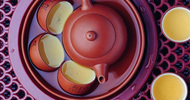
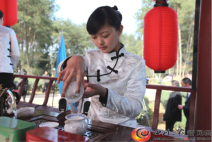

China is the home country of tea. Before the Tang Dynasty, Chinese tea was exported by land and sea, first to Japan and Korea, then to India and Central Asia and, in the Ming and Qing dynasties, to the Arabian Peninsula. In the early period of the 17th century, Chinese tea was exported to Europe, where the upper class adopted the fashion of drinking tea. Chinese tea—like Chinese silk and china—has become synonymous worldwide with refined culture. At the heart of the art of tea—the study and practice of tea in all its aspects—is the simple gesture of offering a cup of tea to a guest that for Chinese people today is a fundamental social custom, as it has been for centuries. China traces the development of tea as an art form to Lu Yu, known as “the Saint of Tea” in Chinese history, who lived during the Tang Dynasty and who wrote The Book of Tea, the first ever treatise on tea and tea culture. The spirit of tea permeates Chinese culture, and throughout the country there are many kinds of teas, teahouses, tea legends, tea artifacts and tea customs. Better-known places to enjoy a good cup of tea in China include Beijing noted for its variety of teahouses; Fujian and Guangdong provinces and other places in the southeast of China that serve gongfu tea, a formal serving of tea in tiny cups; the West Lake in Hangzhou, also the home of the Tea Connoisseurs Association, noted for its excellent green tea; and provinces in southwest China like Yunnan where the ethnic groups less affected by foreign cultures keep tea ceremonies and customs in original tea-growing areas. (307 words)
1. How was Chinese tea exported to foreign countries before the Tang Dynasty?2. How much do you know about gongfu tea? Please share your knowledge about gongfu tea with your partner.
People in different parts of China have different ways to celebrate the Mid-Autumn Festival. But one traditional custom has definitely remained and is shared by all the Chinese. This is eating the festive specialty: cakes shaped like the moon.
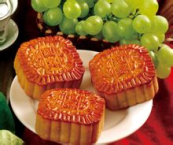
Moon Cake is the food appearing everywhere at any celebration of this traditional festival, not only because of its delicious taste and charming looking, but also for the cultural and artistic connotation. Nowadays, moon cakes with their various flavors and delicate packaging actually have become a kind of artwork. People can also get artistic pleasure while enjoying the food.
Moon cakes are round pastries that are about an inch in height. Inside, they are filled with lotus seeds, red bean paste, orange peel, melon seeds, ham, dried flower petals, and salted duck’s egg yolk. The surface of the food is patterned with clouds, the moon, and the rabbit.
It symbolizes the reunions of families and couples. The exchanging of gifts during the mid autumn festival is one of the hospitable custom and lovers would also give moon cakes as presents to show their passions.
The custom of eating moon cakes can date back to thousand of years ago, having a close relationship with Chinese culture and history. In Chinese ancient literary history, a considerable number of poets and intellectuals created many classic poems and articles about the Mid-Autumn Festival and Moon Cakes. In Chinese fairy tales, there lived on the moon the fairy Chang'er, a wood cutter named Wu Gang and a jade rabbit which is Chang’er’s pet. In the old days, people paid respect to the fairy Chang’er on the Mid-Autumn Festival.
1. What does the moon cake stand for in Chinese culture?2. Describe what does the moon cake look like?
A friend asks me “Why Chinese don’t go Dutch?” So I want to regard this question as the topic and write an article. As everyone knows, westerners will go Dutch while having a meal in the restaurant. But Chinese don’t go Dutch. Chinese will pay the bill and check out generously. Occidental don’t often entertain guests; but Chinese often invite friend to dinner. A lot of occidentals feel puzzled to this question.
Why does such a difference exist? Because the East and West culture and custom are different on the surface. I will analyze this question concretely.
First of all, food systems between China and Occident are different. Chinese put into practice Gather Dining System; Occidentals put into practice Individual Dining System. Everybody can share the delicious food of all over the table when eating Chinese food. Please note it is sharing; but Occidentals just eat the food in one’s own plate. If you eat beef, he eats chicken. It is impossible that you taste the flavor of his chicken. The result of the Individual Dining System is that you can only eat the food in your plate. It is unable to share. Ha-ha! What I said is right!
So to eat Chinese food is happier than to eat Western-style food. And I want to ask you a question. Do you like the free thing? I think nobody don’t like the free thing. Ok! Suppose I invite you to eat the delicious Chinese food, then I pay the bill. This is equal to that you have enjoyed a delicious Chinese food free. So you will be very glad. The friendship between the friends has been strengthened in this kind of atmosphere.
Secondly, Occidentals eat for health; Chinese eat for the friendship. Occidental advocate individualism and independence is strong. So Occidental express that respect for each other’s independence through the way of going Dutch. Chinese like making friends and solidarity. Chinese value the interpersonal relationships and friendship very much. There are a lot of folk sayings in China, for example “Depend on parents at home; while leaving home depends on the friend!”, “Handling affairs is easy if you have many friends!” another sentence is more violent: “Insert the knife into both sides of the rib for friend!”
Therefore, friend’s position is important in Chinese’s mind. The purpose that Chinese don’t go Dutch is that they don’t want to destroy the friendship between the friends. Dutch treatment is the stingy behavior in China, is unfavorable to the friends’ solidarity and is unfavorable to keeping the harmonious interpersonal relationship.
Third, it is only simple “Have a meal!” that Occidental entertain guests. It is not purpose that Chinese entertain guests, but it is the means. In Americans’ idea, “Have a meal” definition is to add fuel to the body for keeping health and normal life activity, thus resisting the attack of disease. That is to say, there is no any additional value.
Chinese are a nation liking treat very much. Generally speaking, one party who propose treat will pay the bill in China. But purposes are different. For example you help me to do a thing; I will invite you to dinner in order to express thankfulness to you. Certainly, I will pay the bill. Suppose I am a company manager, you are another company manager. I talk about the business with you, and I will say: “Let’s have a meal together!” Certainly, I will pay the bill. My purpose is to congratulate success in the business and promote the friendship between us, even the friendship and cooperation between two companies.
In fact, Chinese are very complicated. So I say that Chinese not going Dutch is not merely a kind of folkway and custom, but it is a means, a method, a repayment way, a way to express emotion, even probably a kind of stratagem.
1. What are different food systems between China and western countries?2. Are you in favour of Chinese food system? Why?
3. Why does the writer think eating Chinese food is happier than eating Western-style food?
4. What’s the meaning of the underlined part in the text?
5. Please list some positive and negative purposes of Chinese treat.
In China, foods are given particular meanings, so that a type of food can only be eaten by some specific individuals in certain occasion, or must be eaten in specific occasion.
Usually, an honored guest will be served a snapper’s head or shell to greet him and show warm welcome in some districts.
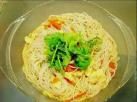
Noodles are the symbol of longevity in Chinese culture. They are as much a part of Chinese birthday celebration as a birthday cake with lit candles is in many countries, so that youngsters or seniors all will have a bowl of Long Life Noodle in the expectation of a healthy life. Since noodles do symbolize long life, it is considered very unlucky to cut up a strand.

Eggs hold a special symbolic significance in many cultures, and China is no exception. The Chinese believe eggs symbolize fertility. After a baby is born, parents may hold a “red egg and ginger party”, where they serve round hard-boiled eggs to announce the birth. (In Central China, the number of eggs presented depends on the sex of the child: An even number, usually six or eight Red Boiled Eggs with a black point dotted on one end will be delivered for a boy and an odd number, usually five or seven without black point for a girl). Egg rolls or spring rolls resemble the shape of a gold bar, and thus are often served on the New Year as a symbol of wealth and prosperity in the coming year.
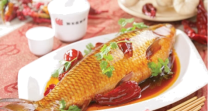
Fish also play a large role in festive celebrations. The Chinese word for fish “Yu” sounds like the homophonic words both for wish and abundance. As a result, on New Year’s Eve it is customary to serve a fish for dinner, symbolizing the wish for accumulations of prosperity and wealth in the coming year. In addition, the fish is served whole, with head and tail attached, symbolizing a good beginning and ending for the coming year.
Ducks represent fidelity in Chinese culture. If you are ever invited to a Chinese wedding banquet, don’t be surprised to spot a mouthwatering platter of Peking duck on the banquet table. Also, red dishes are featured at weddings as red is the color of happiness. (You may find them served at New Year’s banquets for the same reason.)
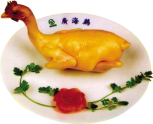
Chicken forms part of the symbolism of the dragon and phoenix in Chinese culture. At a Chinese wedding, chicken’s feet, referred to as phoenix feet, are often served with dragon foods such as lobster. Chicken is also popular at Chinese New Year, symbolizing a good marriage and the coming together of families, and serving the bird whole emphasizes family unity.
Seeds - lotus seeds, watermelon seeds, etc - represent bearing many children in Chinese culture. Visit an Asian bakery during the Chinese New Year, and you’re likely to find a wide assortment of snacks with different types of seeds in them.
There are other foods, snacks and fruits which symbolize good wishes under special circumstances. (498 words)
1. Who will be served a snapper’s head or shell? Why?2. What do noodles symbolize in Chinese culture?
3. What do eggs symbolize in Chinese culture?
4. What do fishes and chickens symbolize in Chinese culture?
5. What do seeds symbolize in Chinese culture?
Talking about eating habit, unlike the West, where everyone has their own plate of food, in China the dishes are placed on the table and everybody shares. If treated by a Chinese host, be prepared for a ton of food. Chinese are very proud of their culture of preparing food and will do their best to show their friendliness.

And sometimes the host will serve some dishes with his or her own chopsticks to guests. This is a sign of politeness. The appropriate thing to do would be to eat the whatever-it-is and say how delicious it is. If you feel uncomfortable with this, you can just say a polite “thank you” and leave the food there. There are some other rules that are suggested you follow to make your stay in China happier, though you will be forgiven if you have no idea of what they are.

Never stick your chopsticks upright in the rice bowl; lay them on your dish instead. Otherwise, it is thought extremely impolite to the host and seniors present. The reason for this is that it seems to wish death upon a person at the table.
Make sure the mouth of the teapot is not facing anyone, which means they are not popular. The mouth should always be directed to where nobody is sitting, usually just outward from the table.
Don’t tap on your bowl with your chopsticks, since that will be considered offending to the host or the chef. Beggars tap on their bowls, and also, when the food is coming too slow in a restaurant, people will tap their bowls. If you are in someone’s home, it seems like hurting the feelings of the host or the cook.
Never try to turn a fish over and remove its bones yourself, since the separation of the fish bones from the lower half of the flesh will usually be performed by the host or a waiter.
| Title | Table |
| Introduction | ◆ As for eating habit, there is much ◆ Chinese People take |
| Situations and solutions | ◆ When ◆ If unpleasant with the food, the guests can express their |
| The | ◆ Placing two chopsticks down in a bowl of rice indicates your wish that a person present would ◆ That the teapot mouth faces someone means you want the guest to leave. ◆ Tapping bowls means you are not ◆ |



